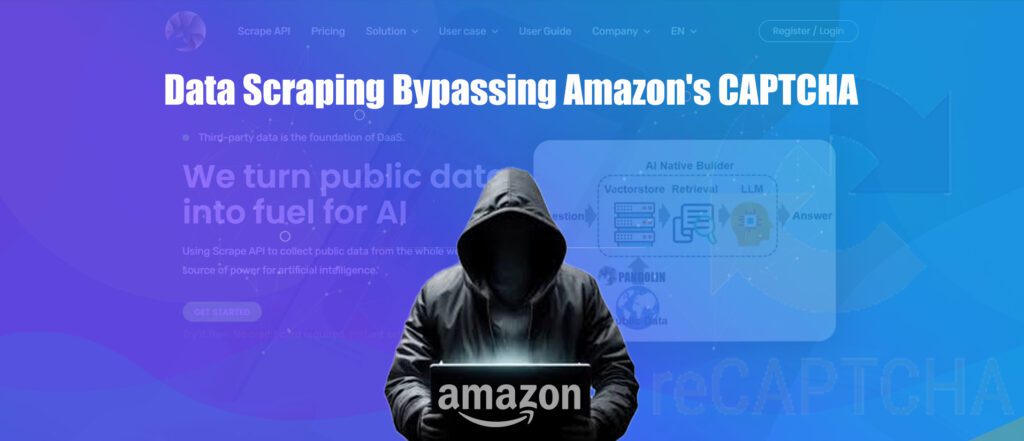Introduction
In e-commerce data analysis, web scraping technology is increasingly widely used. By using web scraping, we can efficiently obtain a large amount of e-commerce platform data, which is extremely important for market analysis, competitive intelligence, price monitoring, etc. Amazon, as one of the world’s largest e-commerce platforms, is a key target for data scraping. However, Amazon has set up a CAPTCHA mechanism to protect the security and normal operation of its website, which poses a great challenge to web scraping. This article will detail how to bypass Amazon CAPTCHA restrictions in data scraping, helping readers understand related technologies and precautions.
1. Overview of Amazon CAPTCHA
Definition and Technical Implementation
CAPTCHA (Completely Automated Public Turing test to tell Computers and Humans Apart) is a verification technology used to distinguish between computers and humans. Common CAPTCHAs on Amazon include image CAPTCHAs and character CAPTCHAs, which require users to input specific characters or select specific images to verify their identity.
Analysis of CAPTCHA Occurrence Reasons
Protect Website Security
The primary purpose of CAPTCHA is to protect the website from malicious attacks and ensure its security. By setting up CAPTCHAs, automated malicious scraping and attacks can be effectively prevented.
Prevent Malicious Scraping
CAPTCHAs are also used to prevent malicious web scrapers from excessively scraping data, which can impact the normal operation of the website. Malicious web scraping can lead to high server loads, affecting the user experience.
Maintain Normal Website Operation
Through CAPTCHA mechanisms, Amazon can maintain the normal operation of its website, avoiding traffic loads and data leakage problems caused by web scrapers.
2. CAPTCHA Recognition and Bypass Strategies
Types and Characteristics of CAPTCHAs
Common types of CAPTCHAs on Amazon include image CAPTCHAs and character CAPTCHAs. Image CAPTCHAs usually require users to select specific images, while character CAPTCHAs require users to input characters displayed in an image. These CAPTCHAs are random and varied, increasing the difficulty of recognition and bypassing.
Common CAPTCHA Bypass Technologies
Image Recognition Technology
Image recognition technology involves training machine learning models to recognize the content of CAPTCHA images. This technology requires a large number of CAPTCHA samples for training to improve recognition accuracy.
Use of Proxy IPs
Using proxy IPs can avoid frequent requests from the same IP address, reducing the risk of detection and banning. Proper configuration and management of proxy IPs are required to ensure the stable operation of the web scraper.
Browser Automation Tools
Browser automation tools (such as Selenium) can simulate real user operations, automatically completing CAPTCHA recognition and input. This method reduces the likelihood of detection by mimicking user behavior.
3. Technical Implementation Details
Environment Preparation
Choosing a Suitable Programming Language (Python)
Python is a powerful and easy-to-use programming language, ideal for writing web scrapers. It has a rich set of libraries and frameworks that can significantly simplify the development process of web scrapers.
Installing Necessary Libraries
Before writing the web scraper, some necessary libraries need to be installed, such as Selenium, BeautifulSoup, etc. These libraries provide powerful functions to facilitate web data scraping and processing.
pip install selenium beautifulsoup4 requests
Python Code Implementation
Basic Web Scraper Framework
First, we need to set up a basic web scraper framework that includes request sending, page parsing, and other basic functions.
from selenium import webdriver
from bs4 import BeautifulSoup
import time
# Initialize WebDriver
driver = webdriver.Chrome()
# Access the target page
driver.get('https://www.amazon.com')
# Wait for the page to load
time.sleep(3)
# Get the page content
html = driver.page_source
# Parse the page content
soup = BeautifulSoup(html, 'html.parser')
# Extract the required data
data = soup.find_all('div', class_='example-class')
# Close WebDriver
driver.quit()
# Print the extracted data
for item in data:
print(item.text)
CAPTCHA Recognition and Processing Logic
To bypass CAPTCHAs, we can use image recognition technology. Here is a simple example demonstrating how to use Selenium to automate CAPTCHA processing.
from selenium import webdriver
from selenium.webdriver.common.by import By
import time
import pytesseract
from PIL import Image
# Initialize WebDriver
driver = webdriver.Chrome()
# Access the target page
driver.get('https://www.amazon.com')
# Wait for the page to load
time.sleep(3)
# Find the CAPTCHA image and take a screenshot
captcha_image = driver.find_element(By.ID, 'captcha-image')
captcha_image.screenshot('captcha.png')
# Use pytesseract to recognize the CAPTCHA
captcha_text = pytesseract.image_to_string(Image.open('captcha.png'))
# Input the recognized CAPTCHA
captcha_input = driver.find_element(By.ID, 'captcha-input')
captcha_input.send_keys(captcha_text)
# Submit the form
submit_button = driver.find_element(By.ID, 'submit-button')
submit_button.click()
# Close WebDriver
driver.quit()
Proxy IP Configuration and Management
Using proxy IPs can effectively avoid the risk of banning due to frequent requests from the same IP. Here is a simple example demonstrating how to configure proxy IPs in Selenium.
from selenium import webdriver
from selenium.webdriver.common.proxy import Proxy, ProxyType
# Configure proxy IP
proxy = Proxy()
proxy.proxy_type = ProxyType.MANUAL
proxy.http_proxy = 'http://your-proxy-ip:port'
proxy.ssl_proxy = 'http://your-proxy-ip:port'
capabilities = webdriver.DesiredCapabilities.CHROME
proxy.add_to_capabilities(capabilities)
# Initialize WebDriver and use proxy
driver = webdriver.Chrome(desired_capabilities=capabilities)
# Access the target page
driver.get('https://www.amazon.com')
# Close WebDriver
driver.quit()
Precautions
Adhere to Amazon’s Terms of Use
When performing data scraping, you must adhere to Amazon’s terms of use to avoid infringing on its legal rights.
Avoid Frequent Requests Leading to IP Bans
Use proxy IPs and set reasonable request frequencies to avoid IP bans due to frequent requests.
Code Robustness and Exception Handling
Write robust code and handle potential exceptions to ensure the stable operation of the web scraper.
4. Case Code Explanation
Below is a complete web scraper case with a detailed explanation of each step.
from selenium import webdriver
from selenium.webdriver.common.by import By
from bs4 import BeautifulSoup
import time
import pytesseract
from PIL import Image
def fetch_amazon_data():
# Initialize WebDriver
driver = webdriver.Chrome()
try:
# Access the target page
driver.get('https://www.amazon.com')
# Wait for the page to load
time.sleep(3)
# CAPTCHA processing
if "captcha" in driver.page_source:
captcha_image = driver.find_element(By.ID, 'captcha-image')
captcha_image.screenshot('captcha.png')
captcha_text = pytesseract.image_to_string(Image.open('captcha.png'))
captcha_input = driver.find_element(By.ID, 'captcha-input')
captcha_input.send_keys(captcha_text)
submit_button = driver.find_element(By.ID, 'submit-button')
submit_button.click()
time.sleep(3)
# Get the page content
html = driver.page_source
soup = BeautifulSoup(html, 'html.parser')
# Extract the required data
data = soup.find_all('div', class_='example-class')
for item in data:
print(item.text)
except Exception as e:
print(f"An error occurred: {e}")
finally:
# Close WebDriver
driver.quit()
# Run the web scraper
fetch_amazon_data()
In this case, we use a combination of Selenium and BeautifulSoup to access the Amazon page and extract data. Meanwhile, we use pytesseract to recognize the CAPTCHA, successfully bypassing the CAPTCHA restriction.
5. Difficulties and Breakthroughs in Bypassing CAPTCHAs
Difficulty Analysis
Complexity and Diversity of CAPTCHAs
The complexity and diversity of CAPTCHAs make recognition difficult. Amazon continuously updates its CAPTCHA mechanisms, increasing the difficulty of recognition and bypassing.
Dynamic CAPTCHA Mechanism Updates
Amazon’s CAPTCHA mechanisms are dynamically updated, requiring our recognition algorithms to constantly iterate and update to adapt to new CAPTCHA formats.
Breakthrough Strategies
Using Advanced Image Recognition Technology
Utilizing deep learning and advanced image recognition technologies can improve CAPTCHA recognition accuracy. Through a large amount of training data and optimized models, complex CAPTCHAs can be effectively handled.
Multi-IP Strategy and IP Pool Management
Adopting a multi-IP strategy and IP pool management can effectively avoid the risk of banning due to frequent requests from the same IP. Proper configuration and management of the IP pool can improve the stability and success rate of the web scraper.
Possibility of Manual Assistance in Recognition
In some cases, combining manual assistance in recognition can improve CAPTCHA processing efficiency. This method is suitable for scenarios where CAPTCHAs are complex and recognition rates are low.
6. Risk Analysis of Scraping Amazon Site Data
In the process of scraping Amazon data, we face multiple risks that need to be carefully addressed and mitigated.
Legal Risks
Infringement of Intellectual Property Rights
Scraping Amazon data without permission may infringe on its intellectual property rights. This behavior could lead to legal proceedings and even substantial compensation. Therefore, we must understand and comply with relevant laws and regulations to ensure the legality of data scraping activities.
User Privacy Protection
During data scraping, we may obtain data involving user privacy. We need to strictly comply with privacy protection laws, such as the General Data Protection Regulation (GDPR), to ensure that we do not infringe on users’ privacy rights.
Technical Risks
IP Banning
Frequent requests can lead to IP addresses being banned. To avoid this, we need to use proxy IPs and set reasonable request frequencies.
CAPTCHA Mechanism Updates
Amazon continuously updates its CAPTCHA mechanisms, posing new challenges to web scraping technology. We need to constantly optimize and update our recognition algorithms to adapt to new CAPTCHA formats.
Business Ethics Risks
Malicious Competition
Using web scraping technology for malicious competition, such as maliciously scraping competitor data, can harm the fair competition environment of the industry. This behavior is not only unethical but can also lead to legal disputes.
Data Misuse
Improper use of scraped data can negatively impact users and platforms. Therefore, we need to strictly control the scope of data use to ensure the legal and compliant use of data.
To mitigate these risks, we must comply with relevant laws and regulations during data scraping, maintain fair competition in the industry, and ensure the legal and compliant use of data.
7. A Better Choice – Pangolin Scrape API
Introduction to Pangolin Scrape API
Pangolin Scrape API is an efficient and secure solution designed for data scraping. It provides a series of powerful features to help users easily achieve data scraping tasks.
Features and Advantages
Scraping by Specified Postal Area
Pangolin Scrape API supports scraping by specified postal areas, allowing users to scrape data from specific regions as needed, offering high flexibility.
SP Ad Scraping
This API also supports SP ad scraping, enabling users to obtain advertisement data from the Amazon platform, providing strong support for market analysis.
Hot Sale and New Release List Scraping
Pangolin Scrape API can efficiently scrape data from Amazon’s hot sale and new release lists, helping users understand market trends and new product information.
Flexibility in Scraping by Keywords or ASINs
Users can scrape data based on keywords or ASINs, making the operation simple and highly flexible.
Performance Advantages and Data Management System Integration
Pangolin Scrape API offers high performance, capable of processing large amounts of data quickly, and can seamlessly integrate with users’ data management systems, improving work efficiency.
The features and advantages of Pangolin Scrape API make it an ideal choice for data scraping. By using this tool, users can efficiently and securely scrape data from Amazon while avoiding the risks faced by traditional web scraping technologies.
8. Conclusion
Reaffirming the Importance of Web Scraping Technology in Data Scraping
Web scraping technology is crucial in e-commerce data scraping, helping users efficiently obtain valuable data. This data is essential for market analysis, competitive intelligence, price monitoring, etc., providing data support for enterprise decision-making.
Emphasizing the Necessity of Reasonable and Legal Use of Web Scraping Technology
When performing data scraping, it is essential to comply with relevant laws and platform terms of use to avoid infringing intellectual property rights and user privacy. Reasonable and legal use of web scraping technology can not only mitigate legal risks but also maintain a fair competition environment in the industry.
Comply with Amazon’s Terms of Use and Legal Regulations
When performing data scraping, we need to strictly adhere to Amazon’s terms of use and relevant legal regulations to ensure the legality and compliance of our scraping activities. Violating these terms not only poses legal risks but may also lead to IP bans, affecting the continuity of data scraping.
Use Advanced Technological Means
By using image recognition technology, proxy IPs, and browser automation tools, we can improve the success rate of CAPTCHA recognition and ensure efficient data scraping. These technological means can also help us mitigate certain risks, such as IP bans due to frequent requests.
Recommending Pangolin Scrape API as an Efficient and Secure Choice for Data Scraping
Pangolin Scrape API, as an efficient and secure data scraping solution, offers powerful features and flexibility to meet users’ diverse needs. By using Pangolin Scrape API, users can efficiently and securely scrape data from Amazon, avoiding the risks associated with traditional web scraping technologies.
Efficient Data Scraping Capability
Pangolin Scrape API has efficient data scraping capabilities, capable of processing large amounts of data quickly to meet users’ needs. Whether it is scraping by specified postal area, SP ad scraping, or scraping hot sale and new release lists, Pangolin Scrape API can handle it effortlessly.
Flexibility in Scraping by Keywords or ASINs
Pangolin Scrape API supports scraping data based on keywords or ASINs, making the operation simple and highly flexible. Users can configure scraping parameters flexibly according to their actual needs to obtain the required data.
Secure Data Scraping Environment
Pangolin Scrape API provides a secure data scraping environment, effectively avoiding the risks associated with traditional web scraping technologies. By using Pangolin Scrape API, users can avoid issues like IP bans due to frequent requests, ensuring the continuity of data scraping.
Conclusion
Through this introduction, I hope readers can understand how to bypass Amazon CAPTCHA restrictions in data scraping. Data scraping is significant in e-commerce analysis, but in practice, it is essential to comply with relevant laws and platform terms of use to perform data scraping reasonably and legally. If you have more questions about data scraping or need further discussion, please feel free to contact us. Let us explore more possibilities for data scraping together.
By reasonably using web scraping technology and advanced data scraping tools, we can efficiently and securely obtain data from e-commerce platforms, providing strong support for market analysis and enterprise decision-making. At the same time, we also need to continuously learn and update our technology to cope with ever-changing challenges, ensuring the continuity of data scraping. We welcome readers to exchange and discuss with us, progressing together.






